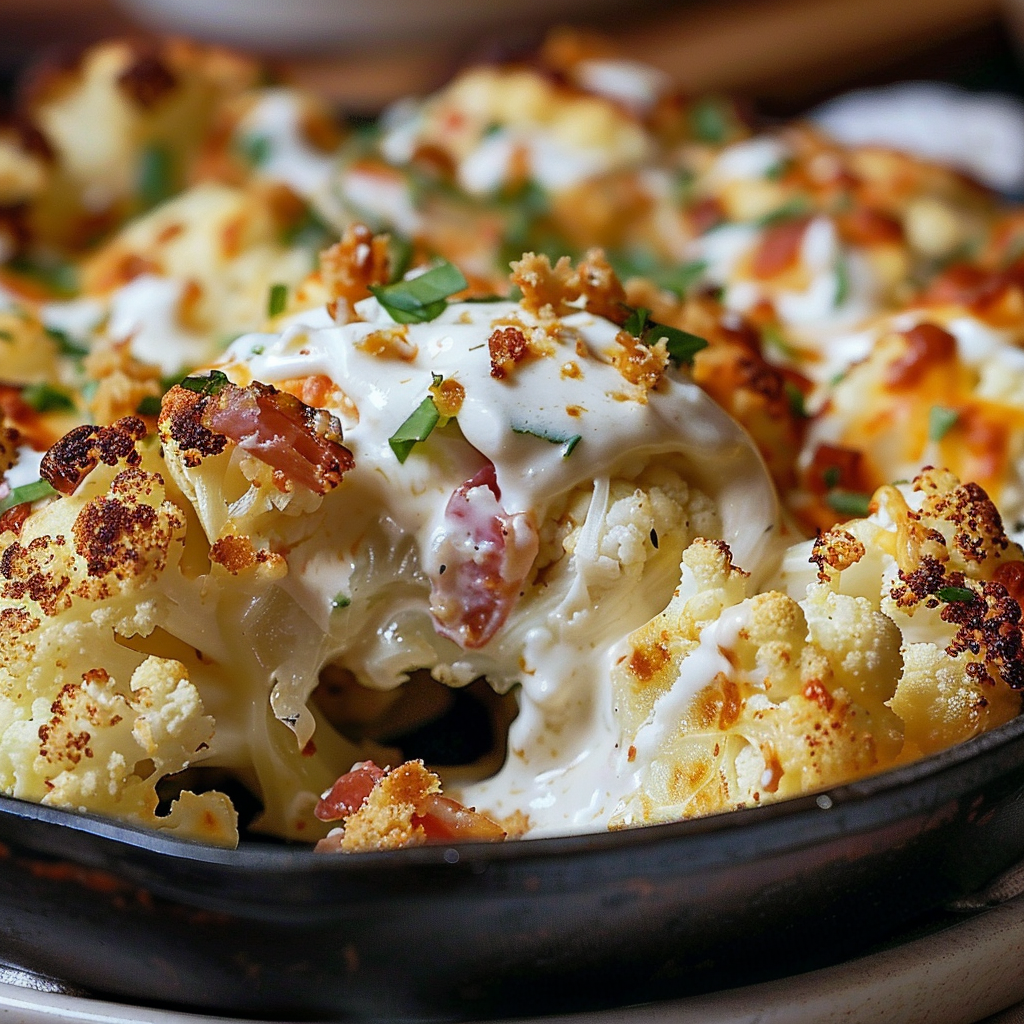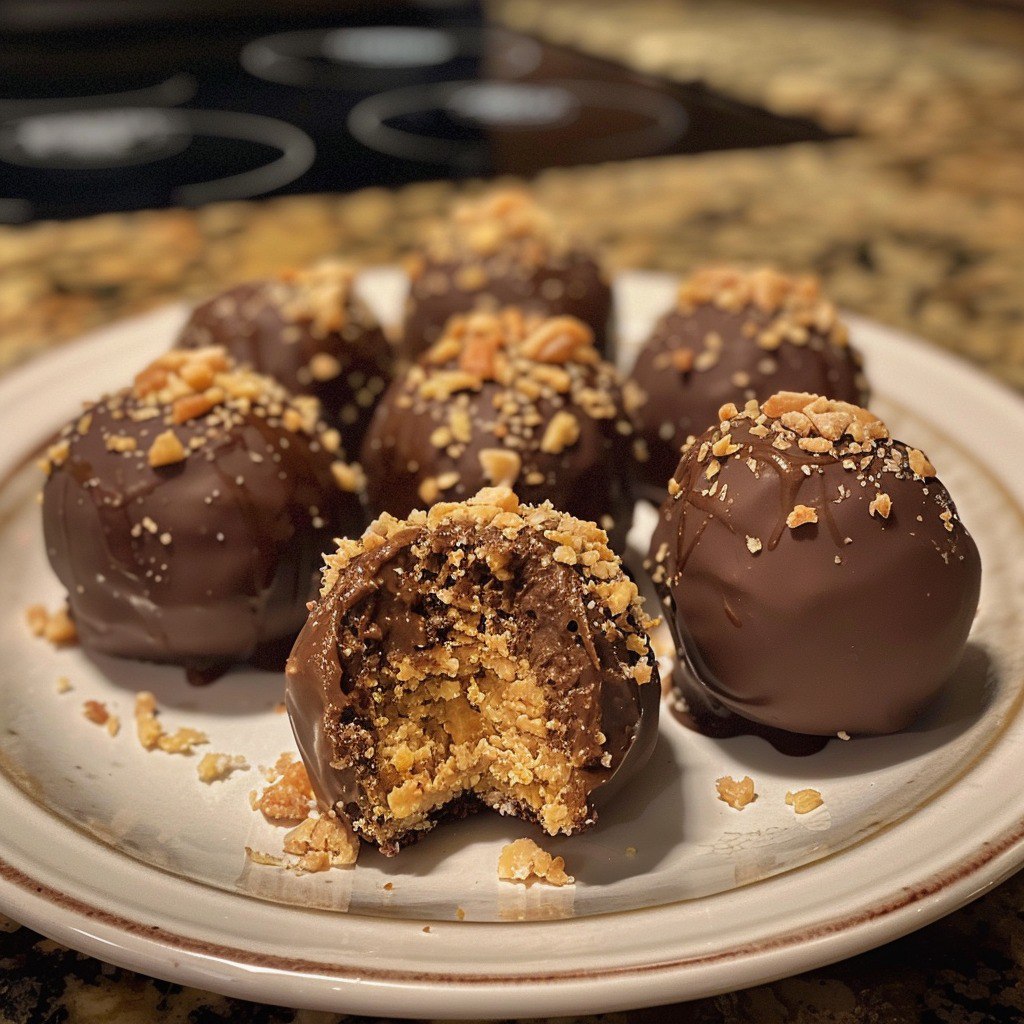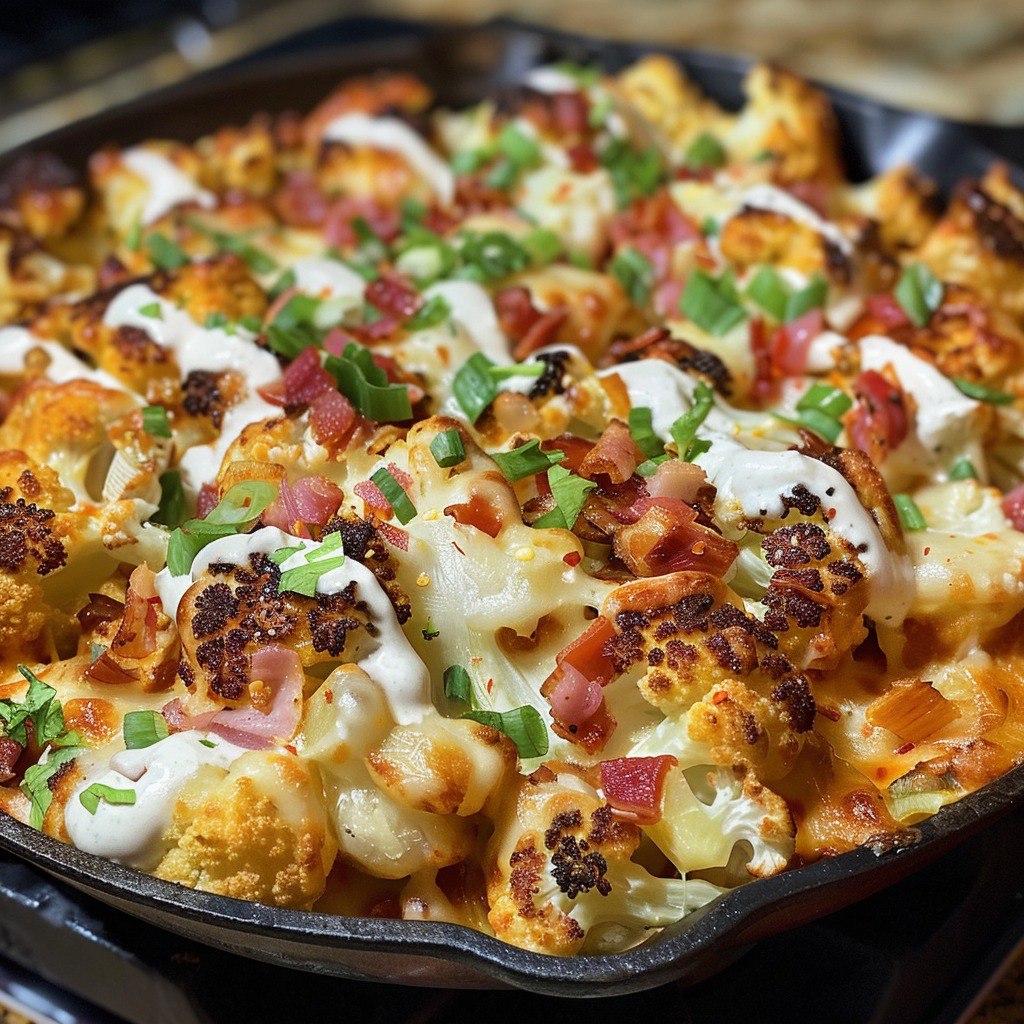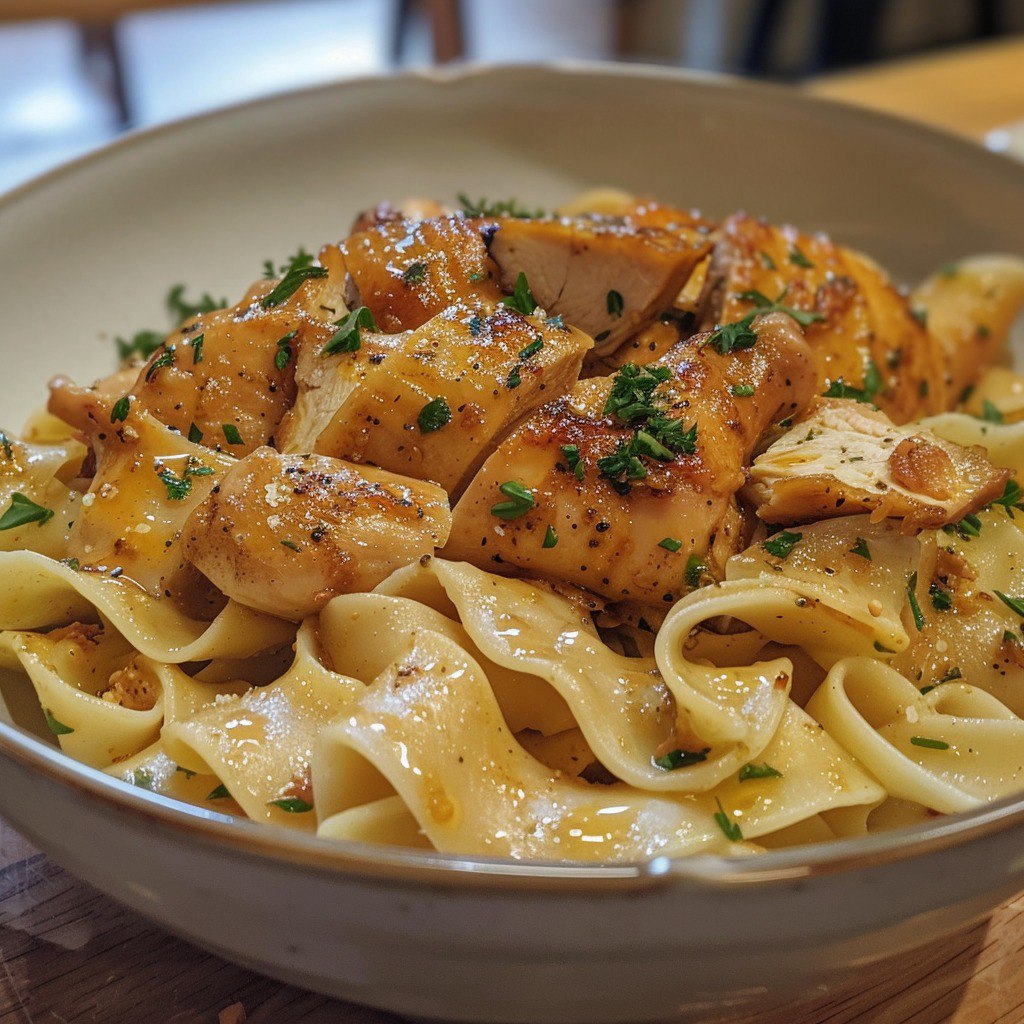Imagine enjoying all the indulgent flavors of loaded baked potatoes without the guilt or carb overload. Loaded cauliflower delivers exactly that experience – transforming humble cauliflower florets into a decadent, satisfying dish that rivals any steakhouse side. This innovative recipe proves that healthy eating doesn’t mean sacrificing flavor or comfort.
Moreover, this remarkable dish has revolutionized how we think about vegetable sides. Additionally, it bridges the gap between healthy eating and indulgent comfort food perfectly. Furthermore, loaded cauliflower satisfies cravings while supporting various dietary goals and restrictions.
Print
The Ultimate Loaded Cauliflower: Your Complete Low-Carb Comfort Food Guide
- Total Time: 35 minutes
- Yield: 4 servings 1x
Description
This Loaded Cauliflower recipe is the ultimate low-carb comfort food! Roasted cauliflower florets are topped with melty cheddar cheese, crispy bacon, sour cream, and fresh green onions for a healthier take on loaded baked potatoes.
Ingredients
- 1 large head of cauliflower, cut into florets
- 1 tablespoon olive oil
- Salt and pepper, to taste
- 1 cup shredded cheddar cheese
- 1/2 cup sour cream
- 4 slices cooked bacon, crumbled
- 2 green onions, thinly sliced
- 1/4 cup chopped fresh parsley (optional, for garnish)
Instructions
- Preheat oven: Preheat to 400°F (200°C). Line a baking sheet with parchment or foil.
- Roast cauliflower: Toss cauliflower with olive oil, salt, and pepper. Spread on baking sheet and roast 20–25 minutes, stirring halfway, until tender and golden.
- Add cheese: Sprinkle cheddar over roasted cauliflower. Return to oven for 3–5 minutes until cheese is melted and bubbly.
- Add toppings: Remove from oven and dollop with sour cream. Top with crumbled bacon, green onions, and parsley if using.
- Serve: Serve warm and enjoy as a hearty side or light main dish.
Notes
- Vegetarian option: Skip the bacon or use vegetarian alternatives like crispy chickpeas or plant-based bacon bits.
- Make ahead: Roast the cauliflower ahead of time and reheat before adding toppings.
- Spice it up: Add a pinch of cayenne or chili flakes for extra heat.
- Prep Time: 10 minutes
- Cook Time: 25 minutes
- Category: Side Dish
- Method: Roasting
- Cuisine: American
Nutrition
- Serving Size: 1 portion
- Calories: 250 kcal
- Sugar: 3 g
- Sodium: 420 mg
- Fat: 19 g
- Saturated Fat: undefined
- Unsaturated Fat: undefined
- Trans Fat: undefined
- Carbohydrates: 7 g
- Fiber: 3 g
- Protein: 10 g
- Cholesterol: 40 mg
Keywords: loaded cauliflower, keto side dish, low carb comfort food, roasted cauliflower, cheesy cauliflower bake
Why You’ll Love This Loaded Cauliflower Recipe
Creating the perfect loaded cauliflower offers numerous benefits that make it an essential addition to your healthy cooking repertoire. Here’s why this transformative dish deserves regular rotation in your meal planning:
It’s dramatically lower in carbs: Contains approximately 85% fewer carbohydrates than traditional loaded potatoes. Perfect for keto, low-carb, and diabetic-friendly eating plans.
It’s surprisingly satisfying: The combination of healthy fats, protein, and fiber creates lasting fullness. Additionally, the rich toppings provide the comfort food experience you crave.
It’s incredibly versatile: Works beautifully as a side dish, light lunch, or even dinner. Moreover, endless topping combinations keep the dish exciting and customizable.
It’s budget-friendly: Cauliflower costs significantly less than premium potato varieties. Furthermore, most toppings are pantry staples that stretch your grocery budget effectively.
It’s naturally gluten-free: Perfect for those with celiac disease or gluten sensitivities. Additionally, it accommodates multiple dietary restrictions simultaneously without compromising flavor.
It’s packed with nutrients: Cauliflower provides vitamin C, fiber, and antioxidants that support overall health. Moreover, the toppings add protein and healthy fats for balanced nutrition.
It’s quick and easy: Simple preparation techniques deliver restaurant-quality results at home. Furthermore, most of the cooking time is hands-off roasting in the oven.
Essential Ingredients for Perfect Loaded Cauliflower
Selecting the Best Cauliflower
The foundation of exceptional loaded cauliflower begins with choosing the perfect head of cauliflower. Look for compact, creamy white florets without brown spots or soft areas. Additionally, the leaves should appear fresh and green, indicating recent harvest and proper storage.
Moreover, size matters when selecting cauliflower for this recipe. Choose heads that feel heavy for their size, indicating dense, moisture-rich florets. Furthermore, avoid cauliflower with loose or spreading florets, which suggest overmaturity.
Fresh cauliflower should have a clean, mild aroma without any sulfurous or unpleasant odors. Additionally, the stem should appear firm and white, not yellowed or dried out. Moreover, proper selection ensures optimal texture and flavor in the finished dish.
Cheese Selection Guide
Quality cheese significantly impacts the final taste and texture of loaded cauliflower. Sharp cheddar provides the classic loaded potato flavor that most people expect. Additionally, its melting properties create the perfect gooey, golden topping layer.
Moreover, consider mixing different cheese varieties for more complex flavors. Monterey Jack adds creaminess while pepper jack contributes mild heat. Furthermore, aged cheddar offers more intense flavor than mild varieties.
Freshly shredded cheese melts more smoothly than pre-packaged alternatives. Additionally, pre-shredded cheeses contain anti-caking agents that can affect melting quality. Moreover, grating your own cheese ensures optimal texture and flavor.
Bacon and Protein Options
High-quality bacon elevates loaded cauliflower from good to extraordinary. Choose thick-cut bacon for better texture and more substantial flavor presence. Additionally, applewood-smoked varieties add subtle sweetness that complements the other ingredients.
Moreover, proper bacon preparation ensures optimal crispiness and flavor distribution. Cook bacon until deeply golden but not overly crisp, as it will continue cooking slightly when added to hot cauliflower. Furthermore, reserve some bacon fat for additional flavor enhancement.
Alternative protein options accommodate various dietary preferences. Turkey bacon provides leaner protein with similar smoky flavors. Additionally, vegetarian bacon bits or crispy chickpeas offer plant-based alternatives that maintain textural interest.
Step-by-Step Guide to Making Loaded Cauliflower
Step 1: Proper Cauliflower Preparation
Begin by preheating your oven to 400°F, ensuring even temperature distribution throughout the cooking chamber. Additionally, line a large baking sheet with parchment paper for easy cleanup and prevention of sticking. Moreover, proper preparation sets the foundation for consistent, professional results.
Remove leaves and cut the cauliflower into uniform, bite-sized florets. Furthermore, consistent sizing ensures even cooking throughout the batch. Additionally, aim for pieces approximately 1-2 inches in diameter for optimal texture balance.
Rinse florets under cold running water and pat completely dry with paper towels. Moreover, excess moisture prevents proper browning and creates steam instead of roasting. Additionally, dry cauliflower develops better caramelization and flavor concentration.
Step 2: Seasoning and Oil Distribution
Drizzle olive oil evenly over the cauliflower florets, using approximately one tablespoon for a large head. Additionally, toss thoroughly to ensure every piece receives oil coating. Moreover, proper oil distribution promotes even browning and prevents sticking.
Season generously with salt and freshly ground black pepper, tossing again to distribute seasonings evenly. Furthermore, salt draws out moisture initially, then penetrates the florets for deeper flavor. Additionally, pepper adds subtle heat that complements the rich toppings.
Arrange seasoned florets in a single layer on the prepared baking sheet. Moreover, overcrowding causes steaming instead of roasting, preventing proper caramelization. Additionally, leave space between pieces for optimal air circulation and browning.
Step 3: Achieving Perfect Roasting
Place the baking sheet in the preheated oven and roast for 20-25 minutes, depending on floret size. Additionally, check for doneness by piercing with a fork – properly cooked cauliflower yields easily but maintains structure. Moreover, visual cues include golden-brown edges and tender appearance.
Stir the cauliflower halfway through cooking time to ensure even browning on all sides. Furthermore, this technique prevents burning while promoting uniform caramelization. Additionally, stirring redistributes any released moisture for better final texture.
Watch for the perfect balance of tenderness and caramelization. Moreover, undercooked cauliflower remains too firm and doesn’t absorb toppings well. Additionally, overcooked florets become mushy and lose their appealing texture contrast.
Step 4: Cheese Melting Technique
Remove the roasted cauliflower from the oven and immediately sprinkle shredded cheese evenly over the hot florets. Additionally, the residual heat begins melting the cheese before returning to the oven. Moreover, even distribution ensures every bite contains melted cheese.
Return the baking sheet to the oven for 3-5 minutes, watching carefully to prevent burning. Furthermore, the cheese should melt completely and become slightly bubbly. Additionally, brief heating preserves the roasted cauliflower texture while creating perfect cheese coverage.
Monitor the cheese closely during this final heating phase. Moreover, excessive cooking can cause cheese to separate or become oily. Additionally, perfectly melted cheese appears smooth and golden without brown spots.
Step 5: Final Assembly and Garnishing
Remove the loaded cauliflower from the oven and work quickly while hot. Add dollops of sour cream strategically across the surface, allowing some to melt slightly from the heat. Additionally, this contrast between hot and cool elements creates textural interest.
Sprinkle crumbled bacon evenly over the sour cream and melted cheese. Furthermore, warm bacon releases additional aroma and flavor into the dish. Moreover, distribute bacon pieces to ensure every serving contains protein elements.
Finish with thinly sliced green onions and chopped fresh parsley for color contrast and fresh flavor. Additionally, these herbs provide brightness that balances the rich, heavy toppings. Moreover, vibrant garnishes create restaurant-quality visual appeal.

Advanced Techniques for the Best Loaded Cauliflower
Temperature Control Mastery
Maintaining consistent oven temperature throughout the roasting process ensures optimal results. Use an oven thermometer to verify actual temperature, as many ovens run hot or cold. Additionally, proper temperature control prevents burning while ensuring adequate caramelization.
Moreover, position the baking sheet in the center of the oven for even heat distribution. Furthermore, avoid opening the oven door frequently, which causes temperature fluctuations. Additionally, consistent heat promotes uniform browning and texture development.
Consider using convection settings if available, reducing cooking time by approximately 5 minutes. Furthermore, convection promotes better air circulation and more even browning. Moreover, this setting creates crispier edges while maintaining tender interiors.
Flavor Enhancement Strategies
Elevate your loaded cauliflower through strategic seasoning additions and techniques. Consider adding garlic powder or onion powder to the initial seasoning mixture. Additionally, these aromatics enhance the overall flavor profile without overpowering the cauliflower base.
Moreover, experiment with different oil varieties for unique flavor contributions. Avocado oil provides neutral taste with high smoke point benefits. Furthermore, olive oil adds subtle fruity notes that complement the vegetable base perfectly.
Additionally, consider finishing with flavored salts or seasoning blends after roasting. Smoked paprika adds depth while herb salts provide complexity. Moreover, these finishing touches create professional-level flavor development.
Texture Optimization Methods
Achieve the perfect balance between tender interiors and caramelized exteriors through proper technique. Cut florets into uniform sizes for consistent cooking throughout the batch. Additionally, consistent sizing prevents some pieces from overcooking while others remain underdone.
Furthermore, avoid overcrowding the baking sheet, which creates steam instead of dry heat. Moreover, steaming produces soft, pale cauliflower without appealing caramelization. Additionally, use multiple baking sheets if necessary for larger batches.
Consider broiling for the final 1-2 minutes to enhance browning and create textural contrast. Furthermore, careful broiling adds appealing color without overcooking the interior. Moreover, watch closely to prevent burning during this high-heat finishing step.
Creative Variations of Classic Loaded Cauliflower
International Flavor Profiles
Transform loaded cauliflower using international seasoning approaches for exciting variety. Mexican-inspired versions might include jalapeños, cilantro, and queso fresco. Additionally, these bold flavors create completely different taste experiences while maintaining the healthy base.
Moreover, Mediterranean variations could incorporate feta cheese, olives, and fresh herbs like oregano and basil. Furthermore, sun-dried tomatoes add intense flavor and appealing color contrast. Additionally, these ingredients create sophisticated, adult-oriented flavor profiles.
Indian-spiced versions might include curry powder, Greek yogurt, and fresh mint. Furthermore, these aromatic spices transform the humble cauliflower into exotic, restaurant-quality dishes. Moreover, cooling yogurt balances warm spices perfectly.
Protein Variations
While bacon remains the classic choice, numerous protein alternatives work beautifully in loaded cauliflower. Grilled chicken pieces add substantial protein for complete meal satisfaction. Additionally, seasoned chicken complements the cheese and vegetable base perfectly.
Moreover, chorizo provides spicy, smoky flavors that create Spanish-inspired variations. Furthermore, the rendered fat from chorizo adds additional richness to the dish. Additionally, this protein choice appeals to those seeking bolder, more adventurous flavors.
Seafood options like crab meat or shrimp create elegant, special-occasion presentations. Furthermore, these proteins feel lighter while maintaining the indulgent comfort food appeal. Moreover, seafood versions work beautifully for entertaining and dinner parties.
Dietary Adaptation Options
Vegan loaded cauliflower accommodates plant-based dietary preferences without sacrificing satisfaction. Nutritional yeast provides cheesy flavor while cashew cream replaces dairy sour cream. Additionally, coconut bacon or seasoned tempeh substitute for traditional bacon.
Moreover, dairy-free cheese alternatives melt well and provide similar textural experiences. Furthermore, these modifications maintain the comfort food appeal while supporting various dietary restrictions. Additionally, plant-based versions often contain fewer calories and saturated fats.
Keto-friendly versions maximize fat content while minimizing carbohydrates further. Full-fat sour cream, extra cheese, and bacon fat enhance richness. Furthermore, these modifications support ketogenic dietary goals while providing maximum satisfaction.
Common Mistakes to Avoid When Making Loaded Cauliflower
Moisture Management Issues
The most common error involves inadequate moisture removal before roasting. Wet cauliflower steams rather than roasts, preventing proper caramelization development. Additionally, excess moisture creates soggy textures that compromise the final dish appeal.
Moreover, avoid washing cauliflower immediately before cooking without proper drying time. Furthermore, trapped water in floret crevices prevents oil adherence and seasoning distribution. Additionally, plan adequate time for thorough drying after washing.
Avoid covering the cauliflower during roasting, which traps steam and prevents browning. Furthermore, uncovered roasting allows moisture evaporation and promotes caramelization. Moreover, proper airflow creates the desired textural contrasts.
Overcrowding Problems
Placing too many florets on a single baking sheet creates steaming conditions instead of roasting. Additionally, overcrowded vegetables cook unevenly and develop poor texture. Moreover, proper spacing ensures adequate air circulation around each piece.
Furthermore, use multiple baking sheets when preparing large batches rather than cramming everything together. Additionally, this technique maintains consistent results regardless of quantity. Moreover, even cooking produces better final presentation and eating experience.
Avoid stacking florets or creating thick layers on the baking sheet. Furthermore, single-layer arrangements promote even browning and cooking. Moreover, proper spacing allows for easy stirring during the cooking process.
Timing and Temperature Errors
Cooking at incorrect temperatures produces disappointing results. Too low temperatures fail to create proper caramelization and browning. Additionally, insufficient heat produces pale, soft cauliflower without appealing textural contrast.
Moreover, excessive temperatures burn the exterior before the interior becomes tender. Furthermore, burned cauliflower develops bitter flavors that overpower the mild vegetable base. Additionally, careful temperature monitoring prevents these common problems.
Avoid rushing the cooking process by increasing temperature inappropriately. Furthermore, proper roasting takes time to develop complex flavors and textures. Moreover, patience produces superior results that justify the additional time investment.
Nutritional Benefits of Loaded Cauliflower
Vitamin and Mineral Content
Cauliflower provides exceptional nutritional value with minimal caloric density. Additionally, it contains high levels of vitamin C, supporting immune function and collagen production. Moreover, one serving provides approximately 77% of daily vitamin C requirements.
Furthermore, cauliflower offers significant amounts of vitamin K, essential for bone health and blood clotting. Additionally, this nutrient supports cardiovascular health and proper calcium utilization. Moreover, adequate vitamin K intake promotes overall skeletal system wellness.
The vegetable also provides folate, crucial for cell division and DNA synthesis. Furthermore, folate supports proper fetal development during pregnancy. Additionally, this B-vitamin plays important roles in energy metabolism and nervous system function.
Fiber and Digestive Health
Loaded cauliflower delivers substantial fiber content that supports digestive health and satiety. Additionally, fiber promotes beneficial gut bacteria growth and regular bowel movements. Moreover, adequate fiber intake reduces risk of various chronic diseases.
Furthermore, the soluble fiber in cauliflower helps regulate blood sugar levels and cholesterol. Additionally, this type of fiber slows digestion and promotes steady energy release. Moreover, stable blood sugar supports weight management and diabetes prevention.
Insoluble fiber adds bulk to stool and promotes regularity. Furthermore, this fiber type supports colon health and may reduce cancer risk. Additionally, proper fiber intake promotes overall digestive system wellness.
Antioxidant Properties
Cauliflower contains powerful antioxidants that protect against cellular damage and inflammation. Additionally, these compounds support immune function and may reduce chronic disease risk. Moreover, antioxidants promote healthy aging and cognitive function.
Furthermore, glucosinolates in cauliflower support liver detoxification processes. Additionally, these compounds may have anti-cancer properties according to preliminary research. Moreover, regular consumption supports overall health and wellness.
The combination of antioxidants and anti-inflammatory compounds makes cauliflower particularly beneficial for long-term health. Furthermore, these nutrients work synergistically to provide maximum protective benefits. Additionally, cooking methods like roasting preserve most antioxidant content.
Storage and Reheating Tips for Loaded Cauliflower
Proper Storage Techniques
Store leftover loaded cauliflower in airtight containers in the refrigerator within two hours of preparation. Additionally, separate components if possible to maintain optimal textures during storage. Moreover, proper storage prevents bacterial growth and preserves quality.
Furthermore, consume refrigerated leftovers within 3-4 days for best flavor and safety. Additionally, label containers with preparation dates to track freshness accurately. Moreover, proper labeling prevents confusion and food waste.
Avoid storing loaded cauliflower at room temperature for extended periods. Furthermore, the dairy components require refrigeration for food safety. Additionally, temperature abuse can cause rapid bacterial growth and foodborne illness.
Optimal Reheating Methods
Oven reheating produces the best texture and flavor restoration. Additionally, spread leftovers on a baking sheet and heat at 350°F for 10-15 minutes. Moreover, this method re-crisps the cauliflower exterior while warming the interior.
Furthermore, avoid microwave reheating when possible, as it creates soggy textures. Additionally, microwaves heat unevenly and can make cheese rubbery. Moreover, oven reheating maintains better textural integrity throughout.
Consider refreshing toppings during reheating for optimal presentation. Furthermore, add fresh sour cream, bacon, and herbs after heating. Additionally, fresh garnishes restore the original visual appeal and flavor balance.
Serving Suggestions and Meal Integration
Main Dish Pairings
Loaded cauliflower pairs beautifully with grilled meats and provides excellent flavor contrast. Additionally, its rich, creamy textures complement lean proteins like chicken breast or fish. Moreover, the vegetable base adds nutritional value to protein-focused meals.
Furthermore, serve alongside grilled steak for classic steakhouse-inspired combinations. Additionally, the indulgent toppings match the richness of beef perfectly. Moreover, this pairing creates satisfying, restaurant-quality meals at home.
Consider pairing with lighter proteins like grilled salmon for balanced nutrition. Furthermore, the cauliflower’s richness complements fish’s delicate flavors. Additionally, this combination provides omega-3 fatty acids and abundant vegetables.
Complete Meal Ideas
Transform loaded cauliflower into a complete meal by adding additional protein directly to the dish. Additionally, grilled chicken pieces or cooked ground turkey create satisfying, one-pan meals. Moreover, this approach simplifies meal planning and preparation.
Furthermore, serve over a bed of mixed greens for added fiber and nutrients. Additionally, the warm cauliflower wilts the greens slightly while maintaining textural contrast. Moreover, this combination creates filling, nutritious meals.
Consider adding roasted vegetables like broccoli or Brussels sprouts for variety. Furthermore, multiple vegetables provide diverse nutrients and flavors. Additionally, colorful presentations appeal to both children and adults.
Holiday and Special Occasion Uses
Loaded cauliflower makes an excellent holiday side dish that accommodates various dietary needs. Additionally, it provides indulgent flavors without the carbohydrate load of traditional sides. Moreover, guests often prefer this healthier alternative to heavy potato dishes.
Furthermore, present in individual ramekins for elegant dinner party presentations. Additionally, individual portions control serving sizes and create upscale appearances. Moreover, personal presentations feel special and thoughtful.
Consider making loaded cauliflower bars for parties, allowing guests to customize their own toppings. Furthermore, this interactive approach provides entertainment and accommodates different preferences. Additionally, DIY stations reduce host preparation time.
FAQs About Loaded Cauliflower
Q: Can I use frozen cauliflower instead of fresh for this recipe?
Yes, frozen cauliflower works well with proper preparation techniques. Additionally, thaw completely and pat dry thoroughly before seasoning and roasting. Moreover, remove excess moisture to prevent steaming during cooking.
Furthermore, frozen cauliflower may require slightly longer cooking time to achieve proper browning. Additionally, the texture will be slightly softer than fresh alternatives. Moreover, frozen options provide convenience and year-round availability.
Consider increasing oven temperature by 25°F when using frozen cauliflower. Furthermore, this adjustment compensates for additional moisture content. Additionally, monitor closely to prevent burning while ensuring adequate cooking.
Q: How can I make loaded cauliflower dairy-free?
Several substitutions create delicious dairy-free versions without sacrificing satisfaction. Use nutritional yeast for cheesy flavor and cashew cream for sour cream replacement. Additionally, these alternatives provide similar textures and flavors.
Moreover, dairy-free cheese shreds melt well and provide comparable results. Furthermore, brands like Violife or Daiya work particularly well for melting applications. Additionally, these options accommodate lactose intolerance and vegan dietary preferences.
Consider coconut cream as another sour cream alternative. Furthermore, full-fat coconut cream provides richness and tanginess. Additionally, this option adds subtle tropical notes that complement the other flavors.
Q: What’s the best way to reheat leftover loaded cauliflower?
Oven reheating produces the best results for maintaining texture and flavor. Additionally, spread leftovers on a baking sheet and heat at 350°F for 10-15 minutes. Moreover, this method restores crispiness while warming thoroughly.
Furthermore, cover with foil if the toppings begin browning too quickly. Additionally, this technique prevents burning while ensuring even heating. Moreover, remove foil for the last few minutes to crisp the surface.
Avoid microwave reheating when possible, as it creates soggy textures. Furthermore, microwaves heat unevenly and can make cheese rubbery. Additionally, stovetop reheating in a covered skillet provides better results than microwaving.
Q: Can I prepare components ahead of time for easier serving?
Absolutely! Many components can be prepared in advance for streamlined serving. Additionally, roast cauliflower up to two days ahead and store refrigerated. Moreover, reheat gently before adding toppings for best results.
Furthermore, cook and crumble bacon several days in advance. Additionally, store crispy bacon in the refrigerator and add directly to hot cauliflower. Moreover, pre-cooked bacon saves significant time during final preparation.
Grate cheese ahead of time and store in airtight containers. Furthermore, freshly grated cheese melts better than pre-packaged alternatives. Additionally, advance preparation allows for quick assembly when serving.
Q: How can I add more vegetables to make this dish even healthier?
Several vegetables integrate beautifully with roasted cauliflower without compromising the loaded concept. Additionally, broccoli florets roast well alongside cauliflower and provide color contrast. Moreover, these vegetables share similar cooking times and techniques.
Furthermore, diced bell peppers add sweetness and vibrant colors. Additionally, they roast quickly and complement the other flavors well. Moreover, peppers provide vitamin C and antioxidants for enhanced nutrition.
Consider adding halved Brussels sprouts for earthy depth and additional fiber. Furthermore, they caramelize beautifully and provide interesting textural variety. Additionally, Brussels sprouts offer similar nutritional benefits to cauliflower.
Conclusion: Mastering the Art of Loaded Cauliflower
Loaded cauliflower represents the perfect intersection of healthy eating and indulgent comfort food, proving that nutritious choices don’t require flavor sacrifices. Throughout this comprehensive guide, we’ve explored every aspect of creating the perfect version of this transformative dish that’s revolutionizing how we think about vegetable sides.
Moreover, this versatile recipe adapts to countless dietary preferences and restrictions while maintaining its essential satisfying character. Whether you’re following keto, low-carb, gluten-free, or simply trying to eat more vegetables, loaded cauliflower delivers exceptional flavor and satisfaction. Additionally, its restaurant-quality presentation elevates any meal from ordinary to extraordinary.




